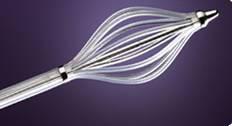On May 7th, I wrote about a study that stated that whole breast radiation following breast conserving surgery may be a better choice than brachytherapy. The study was published in the May 2 issue of the Journal of the American Medical Association. Since the study appeared, a few groups within the medical community, have challenged certain aspects of the study.
What follows is a report on the outcomes of a multi-site study, with a median follow-up of four years, on the uses of Strut-based breast brachytherapy, a 5-day radiation therapy, a form of accelerated partial breast irradiation (APBI), which follows lumpectomy surgery.
The study was presented at the European Society for Radiotherapy & Oncology (ESTRO) World Congress of Brachytherapy in Barcelona, May 10-12. The study documented that breast brachytherapy with a strut-based applicator is a well-tolerated and effective treatment for early-stage breast cancer.
The data from UC San Diego Moores Cancer Center and two other institutions encompasses the longest-term study to date on breast brachytherapy with a strut-based applicator.
 “This longer term follow-up gives more weight to the evidence that strut-based brachytherapy is a valid option for women with early-stage breast cancer,” said Catheryn Yashar, lead author of the study and a radiation oncologist at UC San Diego Moores Cancer Center.
“This longer term follow-up gives more weight to the evidence that strut-based brachytherapy is a valid option for women with early-stage breast cancer,” said Catheryn Yashar, lead author of the study and a radiation oncologist at UC San Diego Moores Cancer Center.

“It’s an approach women should consider,” Dr. Yashar said. “Women lead busy lives and they want a radiation option that will control their cancer, spare their healthy tissue and fit into their schedule more easily than six weeks of whole-breast radiation therapy.”
Other sites participating in the study were Arizona Breast Cancer Specialists (Phoenix,Az.) and 21st Century Oncology (Fort Myers, Fla.)
The research is based on 50 patients treated at those three different institutions with APBI using the Strut-Adjusted Volume Implant (SAVI). Successful completion of treatment was achieved in all 50 cases with favorably low recurrence rates and minimal acute and late toxicities.
“It is significant that these findings encompass patients over a median follow-up of four years since treatment – meaning we now have longer term data with outstanding results that show the efficacy of this therapy,” said Constantine Mantz, M.D., a study co-author and a radiation oncologist and Chief Medical Officer of 21st Century Oncology, the largest radiation oncology provider in the U.S. “One likely reason for these favorable findings is that this technology spares healthy tissues and directs the radiation more precisely to the immediate area that needs to be treated.”
There were no symptomatic cases of seroma, fat necrosis, or breast asymmetry from radiation treatment. Rates of other side effects including fibrosis, breast pain and hyperpigmentation were also reported to be acceptably low.
The cancer recurrence rate in the study was comparable to the recurrence rate reported in the literature for whole-breast irradiation, which takes six weeks and is the traditional form of radiotherapy for early-state breast cancer.
A second study presented at the Barcelona conference, on the dosimetry of a small strut-based APBI device (SAVI 6-1 Mini), showed that the device is an excellent solution for patients with smaller breasts. The finding helps confirm the applicator’s ability to make breast brachytherapy an option for more women.
The 38-month study of 72 patients, by Serban Morcovescu, MS, and physician colleagues at Texas Oncology and North Texas Hospital (Denton, Texas) showed that the breast brachytherapy device, which is the smallest of its kind, allowed for precise targeting of radiation.
Content Sources: Dowling & Dennis Public Relations [email protected]
Cianna Medical , Inc manufacturers of SAVI® (strut adjusted volume implant)

